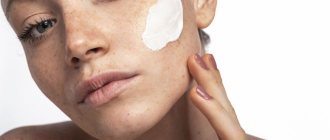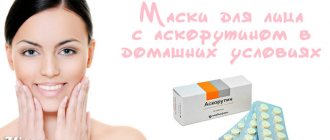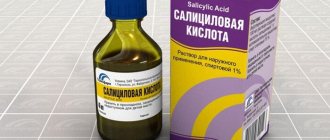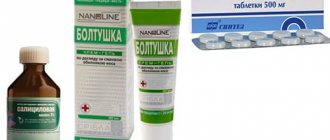To get rid of unwanted pigmentation, it is not necessary to use expensive cosmetics from popular brands. Simple, inexpensive products can also lighten stains quite well. For example, salicylic acid is widely used for age spots. Let's figure out how to choose and how to use this drug correctly.
Salicylic or phenolic acid is included in many commercial whitening products. But you can also use this substance to prepare homemade cosmetic compositions to whiten pigmentation, fight acne and treat some skin diseases.
Initially, salicylic acid was obtained from willow bark, but later a method for its artificial synthesis was invented.
How to choose?
At any pharmacy you can purchase a solution of phenolic acid in ethyl alcohol. Solutions come in different concentrations. For facial care, it is permissible to use a 1% or 2% solution of the product.
Remember! It is prohibited to apply more concentrated solutions to the skin of the face, as this may cause a burn.
The drug is sold in dark glass bottles; it should be stored at room temperature, but out of direct sunlight.
Reasons for appearance
Melanocytes exist in the skin. They produce melanin, which is designed to protect the epidermis. When the normal functioning of melanocytes is disrupted, they rapidly produce pigment. Its excess accumulates in cells, and the skin darkens. The shade can vary from light yellow to brown.
The main prerequisites for malfunctions of melanocytes are:
- genetic predisposition,
- sunburn,
- lack of vitamins,
- problems with the digestive system and liver,
- hormonal imbalance occurring during puberty, pregnancy or menopause,
- elderly age,
- taking strong medications,
- frequent stress.
Any of these reasons can trigger hyperpigmentation. The appearance of dark spots on the face is a reason to be examined by a dermatologist. It is important to find out what triggered the pathology in order to select a comprehensive treatment.
Pigmentation above the upper lip
Whatever the cause of the defect, doctors recommend the use of folk remedies for pigmentation as an auxiliary therapy. Ancient recipes can suppress pigment production and stimulate epidermal cell renewal. Thanks to this, pigmented areas lighten, and the skin takes on a well-groomed, healthy appearance.
Precautionary measures
Using salicylic acid to remove pigmentation requires the following precautions:
- Before first use, you should check the reaction of your skin to contact with the drug. If you are intolerant to the product, itching, severe burning, and peeling will occur. A slight burning or tingling sensation is a normal reaction;
- The product is not suitable for dry skin as it tends to dry out. Those with sensitive skin should avoid using phenolic acid to eliminate age spots on the face, but if there is pigmentation on the body, the product can be used, but with caution;
- it is prohibited to apply phenolic acid to moles and neoplasms of unknown nature;
- It is important to be careful not to let the acid get into your eyes;
- It is not recommended to apply phenolic acid solution and homemade cosmetic compositions based on it on the skin under the eyes;
- Before using the product, it is forbidden to use lotions containing alcohol, this can lead to dry skin;
- after using products with phenolic acid, it is mandatory to use a moisturizing effect;
- It is not recommended to use cosmetics with salicylic acid if there are wounds on the skin;
Do not use the product too often. In its pure form, it can only be applied spotwise to pigment spots every other day .
Based on a solution of phenolic acid, you can prepare homemade compositions - lotions, masks, whitening compresses. Lotions can be used daily in the evenings; masks and compresses are recommended to be used twice a week.
What are the benefits of salicylic acid for the skin?
After the first solution of this drug was obtained in the 19th century, its properties did not change. It did not immediately find its application in cosmetology, so it was originally:
- keratolytic;
- strong antiseptic;
- irritant.
Salicylic acid is an antibacterial, antimicrobial drug that can be used as an external disinfectant. This medication is used to treat wounds, treat dermatological diseases, and cosmetic defects. The solution is able to penetrate deep into the pores of the skin and stimulate blood circulation.
- hides acne spots;
- regulates sebum secretion;
- whitens and dries the face;
- discolors blackheads;
- kills germs that cause acne and pimples.
Salicylic acid is part of many anti-inflammatory and antibacterial products that are produced to solve problems with facial skin. The main task of this element is to disinfect the surface of the fabric, penetrate deep into and destroy bacteria. It should be borne in mind that not only harmful, but also beneficial microorganisms die.
Salicylic acid for skin spots is used both at home and in salon offices. And this popularity of the product is quite obvious:
- The effect on the skin is not aggressive; there is no peeling or red spots left on the skin.
- Thanks to the bactericidal effect, pores are dehydrated and the skin is cleansed.
- The complexion becomes even.
Salicylic acid for the face against age spots is used as follows: you need to apply it pointwise, strictly to the affected area, after five to ten minutes you need to rinse everything off with water. This procedure is carried out twice a day until the desired result is achieved.
Pigmentation on the face occurs for various reasons and, fortunately, it is not at all difficult to deal with. An example of this is salicylic acid - it is an inexpensive pharmaceutical product, thanks to which you can forget about the problem in just a few weeks. But of course, like any treatment, salicylic acid must be used carefully, strictly observing all indications and contraindications.
Methods of application
Let's figure out how salicylic acid is used against age spots. The easiest way is spot application, but you can also prepare various cosmetic compositions based on the product.
Apply precisely
If there is one large pigment spot on the face or body, then you just need to dip a cotton swab in a solution of phenolic acid (1-2%) and lubricate the spot with it, without going beyond its boundaries. After application, a slight tingling sensation may be felt; this is a normal skin reaction.
Do you like your freckles?
Oh yeah! Of course! No, nightmare!
A quarter of an hour after application, you should wash the skin with water or wipe with a cotton pad soaked in tonic. Then apply emollient cream. This procedure must be carried out every other day. During treatment and after its completion, it is necessary to protect the skin from exposure to the sun , otherwise your efforts will be in vain.
Lotion
You can find ready-made salicylic solutions on sale. Those with dry skin can purchase an alcohol-free lotion with the addition of salicylic acid. You can make lotion at home.
Use the prepared composition to wipe the skin twice a day, while avoiding the area of the lips and skin under the eyes.
Chamomile
There are two ways to prepare this remedy. The first method: prepare a chamomile decoction by boiling 0.2 liters of water with the addition of 20 grams of dry inflorescences of a medicinal plant. Let the cooled solution cool, drain the liquid, and squeeze the precipitate through a sieve. Pour 15 ml of 2% salicylic acid solution into the resulting liquid.
Second method: to prepare this lotion you need fresh chamomile flowers, you will need two tablespoons of them. The inflorescences need to be filled with 100 ml of a 2% alcohol solution of salicylic acid. Leave for 72 hours in a dark place. Strain the liquid, pour into a dark glass bottle, and store away from light. To prepare the lotion, mix 200 ml of mineral or just pure water with 20 ml of the prepared alcohol infusion.
Cucumber
To prepare this lotion, you will need to prepare 50 ml of cucumber juice. Mix the strained juice with the same volume of water and pour 10 ml of a 2% phenolic acid solution into the mixture. Store the finished lotion in the refrigerator for no more than five days. Similarly, you can make lotion from strawberry juice.
Recommended use of the prepared products: use twice a day, wiping areas of pigmentation. A quarter of an hour after using the lotion, you should wash your face.
With butter
If the skin is prone to dryness, then it is necessary to add emollient components to formulations with salicylic acid. Prepare the lotion by mixing:
- 150 ml of cold decoction of sage, calendula or chamomile;
- 30 drops of grape seed oil;
- 5 ml of 1% salicylic acid solution.
This composition can be poured into a spray bottle and applied to areas of pigmentation twice a day.
Peeling
The fact that salicylic acid whitens age spots has been known for a long time. One of the most effective procedures is peeling using this product. If possible, this procedure should be carried out in a salon . But you can do peeling at home, taking precautions. Before using the product, it is advisable to consult a dermatologist or cosmetologist.
To lighten pigmentation, it is recommended to carry out 4-5 peeling sessions with a break between procedures of 7-10 days. At home, superficial peeling using a 15% acid solution is allowed. In salons, a cosmetologist can use a more concentrated product.
Carrying out the procedure:
- At least a week before the procedure, you should avoid visiting a solarium, bathhouse, or sauna. Do not use scrubs or other exfoliating products;
- clean the skin and apply a softening homemade mask made from a quarter glass of kefir and a tablespoon of honey;
- wash off the mask, wipe your face with an alcohol-free antiseptic;
- apply the 15% solution with a brush (it is better to protect your hands with gloves);
- rinse off the composition after 5-10 minutes (during the first procedure, the exposure time should not be longer than 5 minutes);
- wash with plenty of cold water;
- wipe your face with an antiseptic solution that does not contain alcohol;
- Apply a thick layer of softening cream, remove the remaining cream after half an hour.
After the procedure, the skin will be red, and after a few days peeling will begin . During this period, it is important to use moisturizers and avoid mechanical exfoliation (do not remove pieces of exfoliating epithelium with your hands!).
During the procedures, the skin's sensitivity to sunlight greatly increases. If you do not provide the skin with effective sun protection, the result of the procedure may be the opposite, and pigmentation may increase even more. Therefore, any peeling is recommended to be done between November and February.
Masks
To whiten pigmentation, you can use a course of masks that contain salicylic acid. Procedures should be carried out twice a week.
There are compositions for masks that are applied pointwise, only to areas of pigmentation. They whiten effectively, but are quite aggressive and very drying. If the areas of pigmentation are large, then softer products should be used; they can be applied to the entire face. The course of masks includes 15 procedures, then you need to give the skin a rest for at least two months.
Here are a few recipes to help get rid of pigmentation:
- With clay. To prepare this composition, it is recommended to use pink or blue clay. A tablespoon of clay should be diluted with milk or cream until the mixture has the consistency of a cosmetic cream, let the mixture stand for ten minutes, then add 30 drops of a 1% phenolic acid solution. Apply for twenty minutes.
- With aspirin. It is necessary to crush several tablets and dilute the resulting powder with a solution of phenolic acid to form a paste. Apply the composition in a thick layer only on age spots, wash off after a quarter of an hour.
- With cocoa butter and honey. This composition option is suitable even for skin that is prone to dryness. You need to melt 5 grams of cocoa butter and mix it with a dessert spoon of honey. Allow the mixture to cool completely, add 15 drops of salicylic acid.
- With glycerin and semolina. Pour a tablespoon of semolina with a small amount of cold milk and let the mixture stand for a few minutes. The semolina should swell and thicken. Add a teaspoon of glycerin and salicylic acid to the thick “porridge.”
- Sour cream and yolk. This composition not only whitens, but also nourishes. Suitable for dehydrated skin. You need to grind one fresh yolk with a tablespoon of homemade sour cream. If you don’t have homemade sour cream, you should buy a product with a fat content of at least 20% in the store. Add 15 drops of 1% phenolic acid solution to the mixture.
- With dry yeast. Instant yeast is suitable for preparing the composition. You need to dilute a packet of yeast with warm liquid. It is best to use a decoction of rose hips, chamomile or green tea. Add liquid in such quantity to form a paste-like mass. Add 20 drops of a 2% salicylic acid solution to the finished mixture. This composition is recommended for whitening pigmentation on oily skin.
Types of age spots and their features
The color and evenness of the complexion depend on the pigments contained in the skin. The absence or insufficient formation of at least one of them contributes to an imbalance and the appearance of darker areas on the surface of the epidermis.
Depending on the cause of origin, there are several types of age spots:
- Freckles are flat spots of various colors that appear on both the face and body.
- Nevi (birthmarks) are neoplasms of various forms that grow throughout life. May be smooth or covered with hairs.
- Melasma is the most common type of hyperpigmentation - spots that appear as a result of insolation (exposure to solar radiation) on the face, décolleté, shoulders and arms. Depending on the sensitivity of the skin, they can be of varying intensity; they often appear after visiting tropical countries, as well as after intensive consumption of citrus fruits, exposure to mineral and essential oils. Melasma darkens in summer and becomes lighter in autumn and winter.
- Chloasma are red-brown pigment spots that appear on the skin due to internal processes in the body (diseases, pregnancy, childbirth, hormonal disorders). They have uneven shapes and can be flat or compacted.
- Lentigo (age spots) are typical for people after 45-50 years of age. The usual location is the face, hands, chest, back. They have different colors and compacted structure.
In addition, pigment spots appear at the site of skin inflammation or squeezed out acne. The reason is that during the inflammatory process, melanin is produced more intensively. Over time, the spots disappear.











